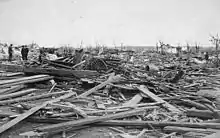1886 Sauk Rapids tornado
The 1886 Sauk Rapids Tornado was a violent tornado that tore through the cities of Sauk Rapids, St. Cloud, and Rice, Minnesota, on April 14, 1886. It destroyed much of the town of Sauk Rapids and killed 72 people along its path. It is the deadliest tornado on record in Minnesota. Other tornadoes occurred in Iowa, Kansas, Missouri, and Texas on the same day, suggesting the possibility of a large outbreak.[2]
| F4 tornado | |
|---|---|
 The Sauk Rapids courthouse in ruins | |
| Formed | April 14, 1886 4:00 p.m. CST |
| Max. rating1 | F4 tornado |
| Damage | $400,000 ($11,382,000 in 2021) |
| Casualties | 72 fatalities, 200+ injuries[1] |
| Areas affected | Central Minnesota, United States |
| 1Most severe tornado damage; see Fujita scale | |
Tornado

At 4:00 p.m., a tornado of approximately F4 intensity cut through the heart of Sauk Rapids. It was one of at least four tornadoes that affected the region between 3:00 p.m. – 5:00 p.m. that day. It had a maximum width of 1/2 mile (0.8 km) and covered an area of 14 miles (22 km).[3] As the storm moved across the Mississippi River, it temporarily sucked the river dry.[3] Some of the structures the tornado destroyed included an iron truss bridge spanning the Mississippi River, the post office, the courthouse, a flour mill, a school, and two churches.[3] Fifteen rail cars were demolished, and iron rails from the train track were pulled up and mangled.[4] After it passed through Sauk Rapids it moved on to Rice, where it killed 11 people in a wedding party when the home they were occupying was destroyed. In all, 72 people were killed by the twister, including 38 in Sauk Rapids and 20 in St. Cloud. Over 200 more were injured. [5]
Relief efforts

St. Benedict's Hospital in St. Cloud, which was spared by the tornado, became the center of relief efforts following the destruction. The Benedictine nuns who operated the hospital worked 48 hours straight until aid arrived from the nearby towns of Minneapolis and St. Paul. Over 50 patients were taken to St. Mary's school and convent in St. Joseph, where the teaching sisters served as nurses.[6]
Impact
Before the tornado struck, Sauk Rapids was considered one of the most important towns in Minnesota and a center of business for central Minnesota.[7][8] It was a blossoming community located on the Mississippi River. However, the tornado changed the economic structure of the entire area, destroying at least 109 commercial and public buildings in Sauk Rapids alone, including every business on Main Street, and causing over $400,000 ($11,382,000 in 2021) in damages.[8][9] After the tornado, St. Cloud became the dominant business center in the region.
See also
Bibliography
Notes
- Welter 2013
- Zurek 2002
- Seeley, Mark W. (2006). Minnesota Weather Almanac. Minnesota Historical Society press. ISBN 0-87351-554-4.
- "Monthly Weather Review" (PDF). National Weather Service. April 1886. Retrieved 2007-05-15.
- E. S. Hill Photographer, St. Cloud, MN 2019
- Dominik, John J. (1986). That You May Find Healing. St. Cloud, Minn: St. Cloud Hospital. p. 8.
- "Sauk Rapids History". City of Sauk Rapids. Retrieved 2007-05-15.
- "Communities In Crisis". Stearns County History Museum. Archived from the original on 2011-03-23. Retrieved 2007-05-15.
- "April in the Upper Midwest". Intellicast. Archived from the original on 2006-08-15. Retrieved 2007-05-15.
References
| Wikimedia Commons has media related to 1886 Sauk Rapids tornado. |
- E. S. Hill Photographer, St. Cloud, MN (2019). "SBM.05d Aftermath of the cyclone in St. Cloud that left 58 dead and hundreds injured, April 14, 1886". Image Collection of the College of Saint Benedict/Saint John's University. Retrieved June 23, 2019.CS1 maint: multiple names: authors list (link)
- Welter, Ben (May 6, 2013). "April 15, 1886: St. Cloud, Sauk Rapids in ruins". Star Tribune. OCLC 43369847. Retrieved June 23, 2019.
- Zurek, Ronald Christopher (2002). Sauk Rapids and Benton County. Arcadia Publishing. ISBN 9780738519609. - Total pages: 128
External links
- Section of With Lamps Burning discussing the cyclone from the book With Lamps Burning, an early history of the Saint Benedict's Monastery, by Grace McDonald. Made available online by the College of Saint Benedict Archives.